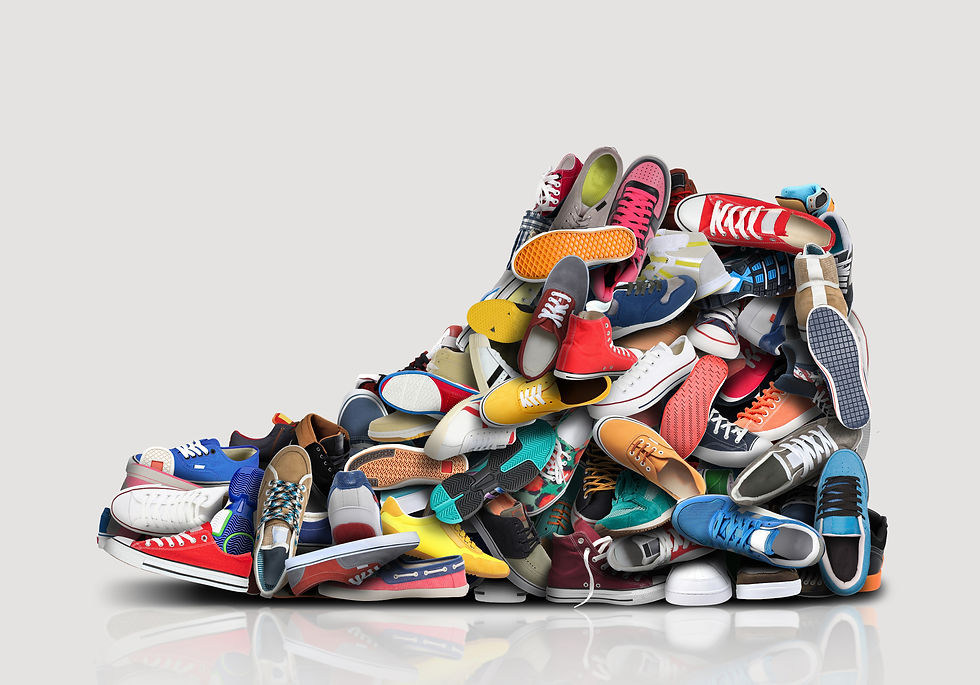Preventing Running Injuries Part II: The Running Shoe
- Svetlana Marianer, MSc PT

- Oct 13, 2022
- 3 min read
Updated: Oct 16, 2022
My previous article‘s main focus was about preventing running injuries and clarifying common myths and misinterpretations that many of us make.

The feedback was great and pushed me to write this follow-up article, focusing solely on the best running shoe that one should opt for when running; the minimalist shoe. The latter is not a specific type of shoe or brand, but rather a concept, which will be described in detail in this article. Prior to diving into this innovative, yet evidence-based subject, let’s review some of the key points made in my previous article.
Myth: Shoe cushioning prevents injury
Our feet are important. They inform us about the surface, absorb our body weight and adapt to the unevenness of the ground. Shoes provide essential protection from the cold and dangerous surfaces, but unfortunately they can also “over-protect” our feet, sending our brains the wrong message throughout much of our daily activities.
Through the increased rigidity of the shoe, the runner’s foot has become lazier and less efficient at processing the essential information that the ground provides. In others words, the brains receives a message telling it that the ground has no unevenness or risk and that the foot doesn’t need to work as hard to protect itself. As a result, the foot slowly loses its ability to adapt and to quickly react to change, such as to different surfaces. This failure to adapt quickly results in injuries as small forces add up or when a larger change is not felt quickly enough i.e. stepping off a curb.
In terms of performance, the elevation of the slope of the shoe causes us to change how we run. This angle means that the first contact is with the heel. This design converts the runner into a heel-striker, as opposed to the preferred running style of mid or forefoot striking. Because the contact is much greater in running as opposed to walking, we want to be able to absorb the ground reaction force through our muscles rather than our joints. This is why it is best to avoid the direct heel to ground contact when running.
Coming back to the excess cushioning and “comfort” make the body feel protected. In turn, this reduces the need to protect us from painful stimuli, such as the contact of the heel with the ground. Therefore when we land on our heels and let our joints absorb the high impact forces of the ground we substantially increase the risk of injury.
How to find the “perfect” running shoe
Ideally, you want a shoe with the least amount of interference with the natural movement of the foot. This minimalism means that the more information the foot gets from the ground, the more accurate the signals from the brain will be to ensure protection of the foot. Whether you are a beginner or simply looking to transition from your current footwear, think about purchasing a minimalist shoe. It is structured to be highly flexible, have a minimal heel to toe drop, a low weight and stack height. and no motion control or stability devices. As part of a study led by researchers from the University of Laval, 42 experts from 11 countries defined the minimalist shoe and build what is called the Minimalist Index (MI) which is composed of the five criteria.
Criteria | Definition | MI |
Flexibility | The shoe is tested its flexibility and malleability | The more flexible the shoe, the higher the MI score. |
Weight | Simply weigh the shoe on a scale | The lighter the shoe, the higher the MI score. |
Stack Height | Measures the thickness of the sole | The thinner the sole, the higher the MI score. |
Stability and Motion Control | Accounts all technologies that promote rigidity or arch support | The less devices added in the shoe (to stabilize the foot or prevent flat feet), the higher the MI score. |
Heel to Toe Drop | The drop is the difference between the shoe thickness under the heel and where the toes start. | The flatter the drop, the higher the MI score. |
An example of a shoe with a minimalist Index of 100% is the Five Finger. In contrast, the Hoka model will be considered as an ultra-Maximalists shoe with an MI of near 0%. The running clinic developed a website in which you are able to search for the minimalist index of your shoe by simply typing its name. A picture and detailed description of your shoe as well as its best use will appear. http://therunningclinic.com/en/shoes
Preventing running injuries- Careful when changing shoes;
It is important to recognize that if you are switching from one footwear to another, the transition should be gradual. In this case, most injuries are caused when the transition happens too quickly. The rule of thumb is that on average, runners should aim for a one month period for every 10% change in the Minimalist Index score. For example, one should plan for a 3 months transition time when switching from a shoe rated 50% to one that’s rated 80%. Staying conservative is key, otherwise more damage than good will be done to the body. Too quick of a transition towards a more minimalist shoe (higher score on the Minimalist Index) will typically result in symptoms to the foot, Achilles tendon or calf muscle. On the other hand, too quick of a transition towards a more maximalist shoe (lower score on the Minimalist Index) will generally cause symptoms to the knee, hip or lower back. In the end, everything is a matter of adaptation and you should listen to your body and make the transition between shoes progressively.
Svetlana Marianer, MSc. Pht




Comments